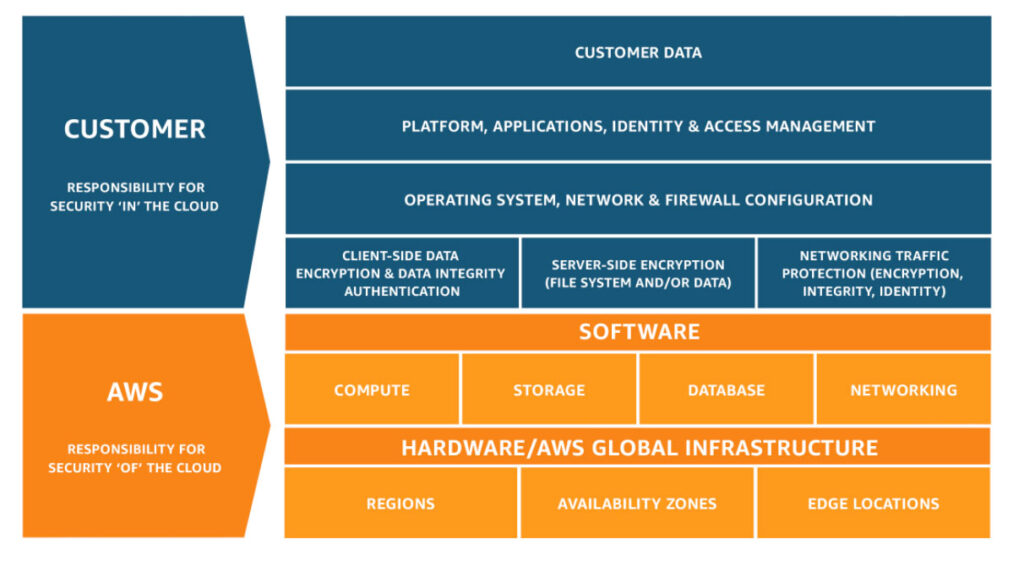As more and more companies move their applications and data to the cloud, security has become a top concern for businesses of all sizes. The AWS Shared Responsibility Model is a security framework that helps customers understand their security responsibilities when using the Amazon Web Services (AWS) cloud platform.
At a high level, the AWS Shared Responsibility Model is based on the principle of shared responsibility, where AWS is responsible for the security of the cloud infrastructure, while customers are responsible for the security of their applications and data running on that infrastructure. In this article, we’ll take a closer look at AWS’s responsibilities and the Customers’ responsibilities in the Shared Responsibility Model.
AWS’s Responsibilities
In the Shared Responsibility Model, AWS is responsible for securing the underlying infrastructure that runs the AWS services. This includes the physical infrastructure such as data centers, servers, and network connections, as well as the virtualization layer including the hypervisor and the virtual machines running on it.
AWS is also responsible for securing the AWS services themselves. This includes providing security features like encryption, access controls, and monitoring to help customers secure their data and applications. AWS also provides tools and services to help customers implement their own security measures, such as AWS Identity and Access Management (IAM) and Amazon GuardDuty.
Physical Infrastructure Security
AWS’s physical infrastructure is designed to meet the highest standards of security and compliance. This includes 24/7 monitoring and surveillance, access controls, and physical security measures such as biometric authentication and perimeter fencing. AWS also employs multiple layers of redundancy and backup to ensure the availability of its services.
Virtualization Layer Security
AWS secures the virtualization layer through the use of hypervisors and virtual machines. The hypervisor provides isolation between virtual machines, ensuring that one compromised virtual machine cannot affect another. AWS also provides a variety of security features for virtual machines, including encrypted storage volumes and secure booting.
AWS Service Security
AWS provides a wide range of security features for its services, including encryption, access controls, and monitoring. AWS also provides compliance certifications for many of its services, including HIPAA and PCI-DSS. Customers can also use AWS services like AWS Shield and AWS WAF to protect against common web-based attacks such as distributed denial-of-service (DDoS) attacks.
In summary, AWS’s responsibilities include:
- Securing the physical infrastructure, such as data centers and network connections.
- Protecting the virtualization layer, such as the hypervisor and virtual machines.
- Securing the AWS services, such as Amazon S3, Amazon RDS, and Amazon EC2.
Customers’ Responsibilities
In the AWS Shared Responsibility Model, customers have a significant responsibility for securing their applications, data, and user access. By understanding their security responsibilities and implementing appropriate security measures, customers can help ensure a secure and compliant environment in the cloud.
Application Security
Customers are responsible for securing the applications running on the AWS infrastructure. This includes configuring firewalls, implementing access controls, and encrypting sensitive data. Customers must also ensure that their applications are free of vulnerabilities and are kept up to date with security patches.
Data Security
Customers are responsible for securing their data in the cloud. This includes encrypting sensitive data, managing access controls, and backing up data regularly. AWS provides a variety of encryption options, including server-side encryption and client-side encryption. Customers must also ensure that they are compliant with applicable data protection regulations.
User Access Management
Customers are responsible for managing their own user accounts and credentials. This includes enforcing strong password policies, implementing multi-factor authentication, and monitoring user activity. Customers must also ensure that user accounts are only granted the necessary permissions to access the resources they need.
Compliance
Customers are responsible for complying with applicable regulations and standards. AWS provides compliance certifications for many of its services, but customers must still ensure that they are compliant with any additional regulations that apply to their business.
In summary, Customers’ responsibilities include:
- Securing their own applications and data, including configuring firewalls, implementing access controls, and encrypting data.
- Managing their own user accounts and credentials.
- Ensuring compliance with regulations and standards, such as HIPAA and PCI-DSS.
The Importance of the AWS Shared Responsibility Model
The AWS Shared Responsibility Model is important because it helps customers understand their security responsibilities when using AWS services. By providing a clear understanding of who is responsible for what aspects of security, the model helps customers create a more secure and compliant environment in the cloud. The model also helps AWS ensure that its customers are using the services in a secure and compliant manner. By defining its security responsibilities, AWS is able to focus on securing the cloud infrastructure and providing the necessary security features to help customers secure their applications and data.
Conclusion
In conclusion, AWS has a significant responsibility for securing the cloud infrastructure and the AWS services themselves. This includes securing the physical infrastructure, the virtualization layer, and the AWS services. However, it’s important to note that AWS’s responsibilities only go up to the infrastructure layer. Beyond that, the responsibility for securing applications, data, and user access lies with the customer. By understanding AWS’s responsibilities in the Shared Responsibility Model, customers can better understand their own security responsibilities and work to create a secure and compliant environment in the cloud. AWS provides a variety of tools and services to help customers implement their own security measures, and by working together with AWS, businesses can create a secure and resilient cloud environment.





